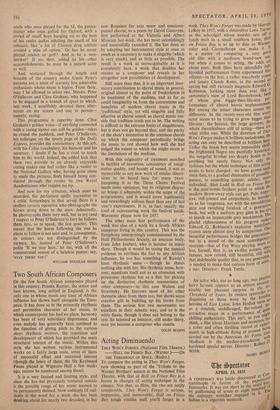Two South African Composers
Or the few South African composers played in this country, Priaulx Rainier, the senior and best known, long settled in England, is the only one in whose music any trace of African influence has shown itself alongside the Euro- pean. It has done so in the primarily rhythmic and percussive character of her music, in which counterpoint has had no place, harmony has been of very subsidiary importance, and even melody has generally been confined to the function of giving pitch to the various short rhythmic motives, the repetition and development of which has provided the main structural interest of the music. Within this style she has written various instrumental works on a fairly large scale, some of them of successful effect and sustained interest (though. the latest of them, the Six Keyboard Pieces played at Wigmore Hall a few weeks ago, cannot be numbered among these).
It is a very limited and limiting style, and since she has not previously ventured outside it the possible range of her music seemed to he permanently defined. Now suddenly (if sud- denly is the word for a work she has been thinking about for nearly two decades), in her new Requiem for solo tenor and unaccom- panied chorus, to a poem by David Gascoyne, first performed at the. Victoria and Albert Museum last-week, she has most astonishingly and successfully extended it. She has done so by adapting her instrumental style at once as much as is necessary to make it singable (which is very much), and as little as possible. The result is a work as unrecognisably as it is completely hers, a work that doubles her stature as a composer and reveals in her altogether new possibilities of development.
Still more than that, it is an important inno- vatory contribution to choral music in general, original almost to the point of freakishness in its treatment of the medium, and as far as could imaginably be from the conventions and banalities of modern choral music in the 'traditional' style, yet still singable and fully effective as choral sound, as choral music out- side that tradition tends not to be. The writing is difficult to the extreme limits of singableness, but it does not go beyond that, and the purity of the choir's intonation in the common chords on which the composer periodically brings the music to rest showed how well she had judged the extent to which she might strain at the limitations of the medium.
With this originality of treatment matched in fertility of invention, 'consistency of imagi- native quality, and beauty of sound, it was as memorable as any new work of similar dimen- sions to be heard here for many years. Imagining it at the Three Choirs Festival needs some optimism, but its religious charac- ter brings it admirably within the scope of the programmes, and it would more legitimately and rewardingly enliven them than any of last year's experiments. It is, in fact, exactly the kind of rejuvenating work the festival needs. Worcester please note for 1957.
The other main first performance of the week was also of a work by, a South African composer living in this country. This was the Symphony enterprisingly commissioned by the Hull Philharmonic Society, an amateur body, from John Joubert, who is lecturer in music there. Though it would be taxing the musical evidence to attribute the fact to any African influence, he too has something of Rainier's keen rhythmic sense — though he shares nothing else with her. His rhythmic sense, how- ever, manifests itself not as an obsession with percussive rhythms but as a flair for picking up the distinctive rhythmic mannerisms of other composers—in this case Walton and Stravinsky. He borrows most of his other thematic ideas from them too, but shows some creative gift in building up his forms from them. The serious first two movements are excellent in their eclectic way, and so is the witty finale, though it does not belong to the rest. So talented an imitator, still under thirty. may yet become a composer who counts, COLIN MASON


















































 Previous page
Previous page